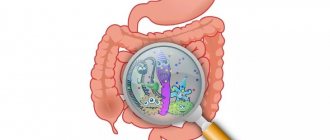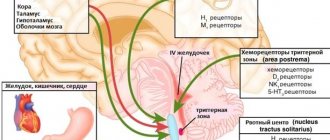Does the shade of green secretion in vomit matter?
Based on the color and consistency of the vomit, one can make the first guess as to the reason that provoked the urge.
First of all, you should pay attention to the factors preceding the violation:
- relationship with food intake;
- intensity and nature of pain;
- frequency of occurrence.
The condition returns to normal after the stomach contents are removed.
| The color of adult vomit: what does it indicate? | |
| Color | Description |
| Green vomit | Vomit turns green due to an increase in the concentration of bilirubin in the blood or the release of bile into the blood. In liver diseases, the masses take on a yellow-green tint; the condition is often accompanied by other symptoms characteristic of liver pathologies, namely:
A similar symptom is characteristic of biliary dyskinesia. Vomiting occurs against the background of slow or frequent contractions. A list of other, no less common reasons can be presented as follows:
There are a sufficient number of reasons for the appearance of green vomit in an adult, some of them are quite dangerous, therefore, if such a symptom is detected, the patient should consult a doctor as an emergency. |
| Red vomit | Gastric bleeding is the first disorder that may be indicated by red vomiting in an adult. In this case, there is no time to delay; the person may lose a sufficient amount of blood. If the blood is bright scarlet, rupture of large vessels is possible. In patients with gastrointestinal ulcers, vomiting of blood may occur after consuming alcoholic beverages. |
| Black vomit | The appearance of black vomit also indicates gastric bleeding. Patients with gastrointestinal disorders often experience black vomiting. The prognosis for this condition depends on the amount of body fluid lost and the duration of bleeding. With timely diagnosis and adequate treatment, the prognosis for recovery is favorable. It is worth remembering that the causes of black vomiting in adults are not always pathological - the possibility of staining the masses as a result of consuming medications or food cannot be ruled out. Black vomiting in an adult can occur as a result of consuming a well-known sorbent - activated carbon. |
| Brown vomit | The vomit is somewhat similar to coffee grounds. This manifestation indicates that the blood in the stomach has clotted. The condition is quite dangerous; you should go to the hospital or call an ambulance. |
| Vomiting with bile | The causes of vomiting bile can be different. In some cases, emptying of the contents manifests itself as a result of acute intoxication, in others it indicates the development of severe diseases of the digestive system. You should not ignore the symptom - you should consult a doctor for a full examination. |
| Yellow vomit | Yellow mucous vomit that appears after eating may indicate the development of liver pathologies. Constant nausea and vomiting may indicate the development of cholelithiasis and urolithiasis. |
During the diagnostic process, it is worth considering that human vomit can significantly change its color depending on the quality of food consumed. For example, with constant consumption of spinach or sorrel, vomit in case of food intoxication will be green. Such a change does not indicate pathology.
The urge to vomit often increases after eating.
As you know, the first symptom of vomiting is a feeling of nausea. After gagging, diarrhea may begin, which is also green in color. The mass may contain particles of undigested food, bile or blood. The patient's condition largely depends on the causes of the disorder.
It is important to drink as much fluid as possible, but in small portions.
In the case where green vomit occurs in an adult patient as a result of food poisoning, after getting rid of the stomach contents the patient feels better. If the urge is provoked by the activity of pathogenic microorganisms, debilitating vomiting provokes an acute deterioration in well-being.
If the vomit has a green-yellow tint, an increase in the acidity of the gastric contents can be assumed. If blood is present in the mass, the development of liver cirrhosis, pancreatitis, and ulcerative-erosive gastritis can be assumed.
In the case where the mass has an earthy color, acute intoxication can be assumed. Black spots may indicate the development of bleeding.
Vomiting often leads to changes in the water-salt balance, therefore, to normalize it and improve their own well-being, the patient must drink enough water. It is worth remembering that you need to drink slowly but often.
Consuming a significant amount of liquid at once may cause repeated vomiting. If nausea is accompanied by stomach pain, you should seek the help of a specialist.
Taking painkillers does not bring positive results; in some cases, such an action can distort the clinical picture.
You should not self-medicate; it is better to seek the help of specialists.
A complete treatment regimen is determined after identifying the causes of nausea. Therapy often involves taking antacids and sorbents. Traditional medicine does not approve of the use of traditional methods of treatment.
The presence of liver secretions in the stomach is indicated by the following signs:
- nausea and heartburn;
- stomach ache. Discomfort can be felt in different areas, and the degree of its intensity depends on the type of toxin and the severity of the pathology;
- belching accompanied by an unpleasant odor;
- covering the tongue with a yellow coating;
- dry mouth that does not go away after drinking liquid;
- a feeling of bitterness in the mouth that persists for a long period of time;
- increased salivation;
- bloating;
- lack of appetite;
- headache;
- frequent breathing.
In case of intoxication, a person's temperature may rise. Diseases of the liver and gall bladder are characterized by a yellow color of the skin and sclera of the eyes, the patient complains of severe itching. With intestinal obstruction, constipation occurs.
The accompanying symptoms of this phenomenon may resemble signs of pathologies, therefore, to find out the correct cause of its occurrence, it is necessary to undergo examination by a gastroenterologist.
The color of the vomit is largely determined by the food eaten. Bile, when mixed with it, should not be green, even if it is green in its pure form. Therefore, rich-colored vomit is either rich in plant foods, for example, dill and parsley eaten, or indicates pathological processes in the body.
If the green vomit was one-time and short-lived, there is no need to worry. In this case, it is advisable to give the patient water to drink (the more, the better), and after 5-6 hours, you can take your usual food.
When not to sound the alarm when the color of vomit changes:
- in the absence of high temperature;
- in the absence of abdominal pain;
- when the patient feels normal;
- in the absence of dizziness and weakness.
The rule applies if the vomiting was one-time. Otherwise, it is recommended to consult a doctor.
Often, bilious vomiting is a sign of stress, fear or prolonged nervous tension. In this case, the person does not require treatment, but only peace and proper rest.
Should I call a doctor?
It is especially urgent to call a doctor in the following situations:
- The child complains of severe abdominal pain.
- The baby has a high temperature.
- The child vomited repeatedly and was accompanied by diarrhea.
- The child ate spoiled food or took any medications before vomiting.
- You notice signs of dehydration in your child.
The younger the baby is, the higher the threat to his life. In addition, any treatment of a child without medical advice can aggravate the situation. Therefore, it is imperative to call an ambulance and show the baby to the pediatrician to find out the real cause of vomiting with bile. The sooner he is examined, the sooner treatment will begin, choosing the right methods of therapy.
You should not delay calling a doctor under the following circumstances:
- child under 5 years old;
- complains of acute abdominal pain;
- general body temperature increased;
- vomiting is repeated many times;
- diarrhea appeared.
There is no need to consult a doctor urgently only if the baby has vomited once, there are no accompanying signs of illness, and the attack has not recurred. But in the near future you need to contact a gastroenterologist for an unscheduled examination. This will help prevent the development of diseases of the biliary system, digestive organs and gastrointestinal tract.
It is especially urgent to call a doctor in the following situations:
- The child complains of severe abdominal pain.
- The baby has a high temperature.
- The child vomited repeatedly and was accompanied by diarrhea.
- The child ate spoiled food or took any medications before vomiting.
- You notice signs of dehydration in your child.
If, after a doctor’s examination and tests, any disease is detected, the baby will be admitted to the hospital for further treatment. It will consist of the following points:
- taking rehydration medications. They will restore the disturbed water-electrolyte balance of the body. One of these drugs is rehydron;
- antibacterial drugs. Indicated in case of diagnosis of intestinal infection. Azithromycin and cefixime have proven themselves well;
- taking sorbents. They are good at removing toxins and other harmful substances from the body. In addition to activated carbon and smecta, children can drink atoxil and enterosgel. The dosage is prescribed by the attending physician;
- antispasmodic drugs. They are able to eliminate painful sensations that appear against the background of smooth muscle spasm. For young children, it is permissible to use no-shpa or drotaverine;
- Motilium and Cerucal are used as drugs that will stop vomiting in a child.
If you provide a sick child with first aid and medical care in a timely manner, you can confidently hope for a speedy recovery without further health consequences. In severe cases, treatment is carried out in hospital. If vomiting occurs in an infant or premature baby, treatment of even a mild degree of the disease should be in a hospital under round-the-clock medical supervision.
Vomiting bile: what to do?
Bile is a biological fluid, the production of which is provided by special liver cells. Bile is yellow-green in color, has a mild odor and a bitter taste. The main function of the secretion is to ensure the processes of food digestion.
Bitterness in the mouth may indicate the presence of bile in the masses.
Vomiting of bile can occur against the background of various disorders in the digestive system and intoxications of the body. Vomiting of bile often occurs in early pregnancy.
Before starting to search for optimal treatment methods, the patient must undergo a complete examination to determine the causes of the pathological disorder. The treatment regimen is determined individually.
The red color of the vomit is due to the discovery of gastric bleeding in the patient. Less commonly, blood inclusions, clots, and traces of blood discharge in the vomit are found as a result of severe stomach cramps that occur directly during the process of vomiting. Red color of vomit, what could be the reasons? Considering that red vomit indicates the presence of blood impurities in it, which means a violation of the integrity of the vessels or tissues of the stomach, it poses an increased danger to human health. When red vomit appears, the only correct solution is to immediately call an ambulance.
The most dangerous situation is in which the vomit blood has a bright scarlet color. This indicates a high probability of damage to large blood vessels. If you vomit red vomit, what does it mean? Vomiting containing bright red blood or streaks of it indicates fresh, rapid bleeding that has opened in some part of the digestive tract.
The blood in the vomit may also be dark red, brown, or black. Consistency ranges from liquid to mushy, reminiscent of coffee grounds. The blood remained in the stomach and reacted with its enzymes and gastric juice. Bloody contents are an obvious sign of disorders that occur in the human body, because blood loss, no matter what it is, is already a damage to health.
- acute inflammatory process of the gastric mucosa as a result of taking non-steroidal anti-inflammatory drugs or alcohol;
— violation of the integrity of esophageal tissue under the influence of alkaline or acidic irritants;
- rupture of the vessels of the esophagus or stomach, associated with an increase in pressure on the veins located in the abdomen;
- rupture of the esophagus due to severe overeating;
- inflammation of the esophagus as a consequence of radio wave treatment;
- tear at the point of transition of the esophagus into the stomach during intense vomiting;
- ulcerative formations in the stomach caused by diseases, burns, alcohol consumption, various injuries, and surgery.
1 Damage to the mucous membranes of the stomach and vascular network of the esophagus. Its appearance is the result of inflammation, internal mechanical damage, and a reaction to the components of medications. The risk of bleeding is especially high with stomach or intestinal ulcers and cancer processes.
2 Varicose veins in the walls of the stomach. If the detected blood is bright, it means the bleeding is fresh. As a rule, it closes quickly and is not dangerous. If its remains are dark, we can conclude that there is long-standing and prolonged bleeding, which can lead to a significant deterioration in health.
3 Ulcerative processes. Causes bleeding in the upper parts of the digestive system. About a third of bleeding is associated with the formation or exacerbation of a stomach or duodenal ulcer.
4 Gastritis in the acute stage. Vomiting of blood in patients with gastritis occurs rarely, mainly due to the consumption of alcoholic beverages. The attacks are short, the volume of blood lost during them is small.
5 Cirrhosis of the liver. Vomiting with blood is a sign of the disease that appears after drinking alcohol. Bleeding is caused by high blood pressure, which ruptures the walls of the vessels in the esophagus. This condition is dangerous for a person’s life; if it occurs, it is necessary to take the patient to a medical facility or call an ambulance as quickly as possible.
Human health in many cases depends on his attention and responsibility. Always remember that blood in vomit is a signal of serious problems with internal organs that pose a threat to your life. Having discovered this symptom, you should not hesitate and self-medicate. Seek assistance only from qualified personnel.
Vomiting of black liquid is most often observed in people under anesthesia, since deep anesthesia can to some extent affect the psyche and physiology of a person. In order to stop the effect of anesthesia, doctors use Reglan and Torekan, which cause blackening of the stomach contents.
Black vomit is a constant companion to chemotherapy of any kind. Nausea can have very different degrees of severity and, as a result, cause vomiting or not. To prevent this condition, doctors recommend not eating anything for several hours before chemotherapy. If nausea does occur, then you need to limit unnecessary movements and try to breathe deeply and slowly.
Brown, red and black vomit may indicate internal bleeding.
A similar sign can be considered a common symptom of some diseases, namely:
- erosive and ulcerative lesions of the gastrointestinal tract;
- inflammation of the stomach or esophagus;
- cirrhosis of the liver;
- oncological processes;
- inflammation of the gallbladder;
- intoxication of the body;
- mechanical damage.
In the case of internal bleeding, vomiting occurs spontaneously, and the patient's condition deteriorates sharply, often in proportion to the volume of blood lost. It is urgent hospitalization, and the assistance provided by a doctor in a hospital, that will help to significantly improve the patient’s condition. The price of delay in matters of treatment in this case is extremely high.
When bleeding occurs, the patient's condition is considered critical.
Vomiting as a symptom of intoxication and damage to the gastrointestinal tract is quite common. Its one-time appearance does not pose a danger to the human body; constant vomiting is dangerous.
Associated symptoms
In severe cases of toxic infection, the patient experiences:
- onset of chills;
- increased heart rate;
- vomiting of an indomitable nature;
- drop in blood pressure;
- painful abdominal cramps;
- feeling of cold extremities;
- cyanosis.
When the cause is Proteus vulgaris, an anaerobic bacterium found in food, the patient experiences liquefied stools with greening of the stool. The condition is complicated by convulsions due to dehydration due to fluid loss due to diarrhea/vomiting. Proper replenishment of what was lost usually helps to recover within a few days.
Poisoning with toxic substances is indicated by vomiting containing green mucus and elevated body temperature. Similar symptoms occur when intoxicated by poisonous mushrooms or poisonous insect bites. This is a reason to seek advice and help from a doctor, since it is impossible to do without competent therapy.
Fever and slimy green vomit may also occur in the following cases:
- With inflammatory process of the kidneys. At first, the disease manifests itself as aching pain in the lower back. You can help yourself by taking painkillers. However, if the pain subsides, the temperature will rise in return. If you feel nauseous and even vomit, consisting of an unpleasant greenish mucous mass, you should not hesitate to call a doctor.
- For food poisoning. About two hours after eating poor quality food, the patient may experience diarrhea accompanied by vomiting and a significant increase in temperature. A regurgitated mass containing green mucus.
- For appendicitis. The resulting pain and spasms in the appendix area are tried to be suppressed with painkillers. However, appendicitis will also manifest itself with vomiting, which is accompanied by a sharp increase in temperature, which cannot be ignored.
- For viral hepatitis and liver diseases. Development begins with fever followed by nausea. Then mucous green vomit opens. Later, these symptoms are joined by other signs of pathology.
- For rotavirus infection (intestinal flu). With a weakened immune system, a person quickly becomes ill even with short contact with an infected object. Symptoms: vomiting with mucus and green diarrhea, high fever. The condition is dangerous due to dehydration, dysbacteriosis and the likelihood of dysentery, which has similar symptoms.
The presence of blood in the vomit indicates internal hemorrhages. Sometimes blood gets into the vomit when flowing from the nose, which is not dangerous, although it causes anxiety due to ignorance. However, each of the following cases, when vomiting appears in the form of a green liquid mixed with blood, requires immediate attention, since it indicates a serious pathology.
Possible reasons:
- internal injuries in the abdominal area;
- damaged gastric/esophageal mucosa;
- alcohol intoxication;
- pressure is higher than normal in the esophagus/stomach area;
- toxic poisoning;
- with varicose veins in the esophagus;
- oncology;
- stomach/duodenal ulcer;
- diseases of the inner ear;
- advanced stage of liver cirrhosis;
- gastritis in acute form.
Particular attention should be paid to bloody vomiting in children and pregnant women, especially if the vomit is emerald or light green in color.
In children this may mean:
- about the development of liver pathologies;
- about bleeding from the nose or lungs;
- about inflammation in the digestive tract.
In a pregnant woman, especially in the final period, such vomiting can be observed as a consequence of a severe form of toxicosis. This puts the life of the mother and fetus at risk due to the risk of critical dehydration.
Reasons for staining vomit
Green vomit indicates the presence of bile in the stomach and increased bilirubin in the blood. Causes of bile reflux into the stomach:
- pathological condition of the sphincter, which regulates the passage of food from the stomach to the duodenum;
- chronic inflammatory processes of the bile ducts, gallbladder, liver;
- intra-abdominal pressure;
- congenital anomalies of the structure of the digestive organs;
- cholecystectomy – removal of the gallbladder;
- disruption of innervation.
Green vomit in humans may be a consequence of functional disorders of the digestive system. The lack of pancreatic enzymes against the background of the predominance of bile determines the color of the digested food. Functional deficiency (insufficient production of mucus, hormones, enzymes). Turns vomit green.
Green bile during vomiting may indicate the presence of a tumor process. This is especially true for intestinal cancer and intestinal obstruction. The tumor compresses the digestive organs and provokes reflux of bile into the stomach.
Green vomit is one of the main symptoms of acute intestinal infection (salmonellosis, typhoid fever, cholera, staphylococcus). With any intestinal infection, the color of the vomit may be greenish.
Green or yellow vomit occurs due to poisoning with chemicals or poisonous mushrooms.
Vomiting is always preceded by nausea. Its intensity depends on the reasons. In case of food poisoning, emptying the stomach contents brings temporary relief. In severe cases, for example, with infectious diseases, repeated vomiting aggravates the general condition of the patient.
The second accompanying symptom is diarrhea. The stool also acquires a characteristic color and consistency, which has diagnostic value in identifying the cause of the disease.
Pathological processes that can be assumed by the nature of vomiting:
- Yellow-green vomiting is the presence of excess bile and hydrochloric acid in the stomach. It happens with increased acidity of the stomach and impaired flow of bile.
- Gray vomit contains a lot of mucus - poisoning from poisons and mushrooms.
- Yellow vomit – eating poor quality foods.
- Brown stomach contents are a dangerous symptom that indicates internal bleeding from the stomach. When interacting with hydrochloric acid, the blood oxidizes and takes on the appearance of “coffee grounds.” Causes: peptic ulcer, polyps, tumors.
- Red vomit is a sign of bleeding from the esophagus. Occurs when poisoning occurs as a result of rupture of the walls of an organ.
- If food in the stomach turns dark green, this is excess bile combined with bleeding.
- If a person vomits masses of black color, this is a sign of an overdose of potent and toxic drugs.
The principles of treatment of vomiting are determined by the causes of the pathological condition. Nausea and vomiting of bile is a pathological sign that indicates a problem with the liver, pancreas, bile ducts or gall bladder. Impurities of liver secretions in the contents of the stomach also indicate poisoning of the body with toxins, alcohol, drugs (for example, after general anesthesia, vomiting of greenish mucus is considered normal) and other substances.
Cholelithiasis (cholelithiasis) is one of the possible causes of the penetration of bile acids into the stomach.
Vomiting of bile is usually preceded by such phenomena as a feeling of nausea, increased salivation, increased respiratory rate, and involuntary swallowing movements. Vomit containing bile is distinguished by a yellow-green color and a bitter taste, the sensation of which persists for a long time in the oral cavity.
The pathology is caused by stone formation in the bile ducts or bladder. Obstruction of the ducts leads to stagnation of liver secretions. But if stones move, they are released in large quantities into the duodenum and penetrate into the stomach. Typical manifestations of cholelithiasis include:
- yellowness of the skin;
- pain in the right side;
- hepatic colic;
- Digestive problems.
If you feel sick with bile and a greenish mass comes out of your stomach, you need to see a doctor. The pathology is fraught with complications, so it is treated primarily surgically.
Cholecystitis
Green bile during vomiting is one of the signs of inflammation of the gallbladder. Cholecystitis is more common in older people. It accompanies cholelithiasis and is manifested by obstructive jaundice, nausea, constipation, and fever. In the calculous form of the disease, stones form in the bladder, causing colic when the smooth muscle muscles contract.
Inflammation disrupts the motility of the organ, causing the flow of bile into the intestines to occur unevenly. When a large portion of liver secretion enters the duodenum, the mucous membrane becomes irritated. Because of this, bile is sometimes thrown into the stomach through the pyloric valve.
After cholecystectomy (excision of the gallbladder), bile directly passes from the hepatic ducts into the small intestine. Almost all patients develop postcholecystectomy syndrome after surgery. Its manifestations include:
- intestinal disorders;
- bitterness in the mouth;
- vomit;
- pain in the side after eating;
- pale skin;
- malaise;
- fast fatiguability;
- flatulence.
Attacks of nausea and vomiting are a consequence of overeating or eating fatty foods. Sometimes symptoms are caused by an overdose of choleretic drugs.
Pyloric stenosis
Pyloric stenosis (pyloric stenosis) is a complication of peptic ulcer disease, in which the walls of the short passage from the stomach to the duodenum narrow. Decreased tone of the pyloric valve and muscular sphincter leads to the reflux of bile acids into the stomach. They irritate the mucous membrane, causing vomiting. Typical manifestations of pyloric stenosis include nausea in the morning, vomiting, and stomach pain after eating.
Pancreatitis
Inflammation of the pancreas is one of the possible causes of vomiting blood. The symptom occurs during an attack of severe pain. Nausea becomes a side reaction to a state of shock. When pancreatitis worsens, the pyloric valve relaxes, causing bile to leak into the stomach. When vomiting, undigested food comes out of the esophagus, followed by a bitter yellow-green liquid. Attacks are caused by drinking alcohol, peppery or fatty foods.
Intoxication
Vomiting during intoxication is a natural attempt by the body to cleanse the gastrointestinal tract of toxic substances and prevent their penetration into the bloodstream. Vomiting of bile in case of poisoning is caused by:
- volatile chemicals;
- fumes from household chemicals;
- low-quality products;
- medicines.
If your stomach hurts, sweating increases and nausea appears, you should take enterosorbents.
After alcohol
Headache and vomiting of bile after drinking alcohol are a clear sign of alcohol intoxication.
Alcohol intoxication is a very dangerous condition for the body, which causes impaired coordination of movements, memory and speech, intestinal disorders, headaches and muscle pain, weakness, nausea and vomiting.
An excess of ethanol leads to impaired motility of the biliary tract, pylorus, sphincters and other gastrointestinal organs. Because of this, liver secretions are thrown into the stomach, causing irritation of its walls. In case of alcohol poisoning, it is necessary to rinse with a weak alkaline solution and take sorbents - Smecta, Polysorb, Enterosgel, etc.
Pregnancy
Vomiting with bile impurities during pregnancy is caused by toxicosis. In 90% of cases, it manifests itself in the early stages, but sometimes worsens several weeks before birth (then called gestosis). Characteristic symptoms of toxicosis include:
- nausea immediately after waking up;
- pain in the lower abdomen;
- bitter taste in the mouth;
- lack of appetite.
Sometimes bile acids in vomit occur during exacerbation of chronic diseases in a pregnant woman - calculous cholecystitis, gastroduodenitis, pancreatitis, etc.
Other reasons
Gagging is a reflex reaction of the body to irritation of the gastric mucosa by toxic substances or the accumulation of toxins in the gastrointestinal tract. Also, the eruption of vomit is caused by the following reasons:
- intestinal obstruction;
- gastroesophageal reflux;
- kidney pathologies;
- cyclic vomiting syndrome;
- overeating (especially typical for children);
- liver diseases;
- mental disorders.
Vomiting is a nonspecific symptom that accompanies many pathologies. To determine the cause of deterioration in health, you need to contact a gastroenterologist.
Symptoms that indicate you need to take your cat to the vet
Yellow vomiting in a cat, which occurs once after eating food, while the general condition and activity of the animal has not changed, is not a cause for concern and, most likely, indicates that the pet simply overate. You should contact your veterinarian in the following cases:
- yellow vomiting lasts for several hours;
- impurities of bile, bloody streaks or a huge amount of yellow mucus are clearly visible in the vomit;
- yellow vomiting in a cat is accompanied by an increase in general body temperature, a decrease in physical activity, and refusal to feed and drink;
- The animal vomits constantly, regardless of food intake.
How to deal with vomiting as an adult?
If vomiting with bile is not a one-time occurrence, it is strongly recommended to call an ambulance. While before the arrival of doctors or a visit to a specialist, a person must be provided with first aid. The fact is that it is precisely this that will make it possible to improve the general condition of a person and eliminate the formation of dehydration of the body.
This is a priority measure that promotes much faster cleansing of the digestive tract. Speaking about this, pay attention to the fact that for rinsing it will be necessary to drink from one and a half to two liters of warm boiled water between the urge to vomit.
In addition, treatment can and even should include the use of activated carbon in a certain ratio, namely one tablet per 10 kg of weight. After this, it will be possible to carry out a special cleansing enema. In addition, it is recommended to give the patient a weak decoction of chamomile, which is consumed in small sips, in order to more successfully stop vomiting with bile.
After vomiting, the patient is advised to rinse the mouth thoroughly. Further, as a course of treatment aimed at reducing the amount of bile released into the intestinal area, an adult may be prescribed medications such as, for example, selective prokinetics. In this case, we are talking about a group of drugs whose effect is aimed exclusively at improving sphincter tone and intestinal emptying: Motilium, Cisapride. In addition, it is advisable to keep in mind some other recommendations:
- The use of antacids is mandatory, because they significantly reduce the acidity of gastric juice. This may be Maalox, Almagel and other means;
- special choleretic preparations are used. They are effective because they make it possible to remove all excess bile from the body, but are characterized by a temporary effect on the body;
- in addition to the use of various medications, it is very important for a person to eat properly so that yellow vomit or any other type does not occur;
- It is prohibited to drink alcoholic beverages; you will also need to avoid eating fatty, spicy and salty foods. This is explained by the fact that such foods irritate the intestinal mucosa and can often provoke an unnecessary release of bile into the stomach area.
Causes and treatment of diarrhea with mucus in a child
What to do when your cat vomits yellow liquid?
- slime;
- foam;
- leftover food.
Overeating
This reaction occurs when there is an abundance of fatty foods in the diet. This is especially evident with a mixed type of nutrition, where industrial feed and natural food are used. In this case, the cat needs a special diet.
Long-haired cats actively lick themselves and the hair gets into the stomach. Over time, it clumps into lumps, which cause gastrointestinal irritation. In case of blockage, vomit contains mucus, blood, and foam. This condition requires urgent surgery.
The most dangerous situation is when the cat vomits bile, he does not eat anything and only drinks water. Symptoms are typical for injuries to internal organs, ingestion of a foreign body. Fish or chicken bones injure and irritate the gastric mucosa. In some cases, surgery is required.
If a cat has yellow vomiting with foam, this may be a sign of infectious diseases - panleukopenia or plague. The vomit will not contain impurities such as hair or food debris.
The gag reflex protects the body from poisoning by toxic substances. Infection with a large number of worms contributes to the development of intoxication. Parasites are a serious irritant and this contributes to the appearance of vomiting.
If this happens during pregnancy, then the cat’s gallbladder pathologies have worsened.
Diseases
The following diseases can lead to this type of vomiting:
- encephalitis;
- peritonitis;
- infectious diseases of the gastrointestinal tract;
- meningitis;
- growth of the thyroid gland;
- neurosis or hysteria;
- toxicosis ketoacidosis;
- high blood pressure: hypertension;
- seasickness;
- malignant formation in the gastrointestinal tract.
People often experience pain after eating due to gastritis. This often happens due to increased production of gastric juice or sudden spasms of the stomach walls. Below is a broader list of painful sensations in the stomach.
The most common and understandable cause of nausea and subsequent vomiting is overeating. When the stomach is filled with a large amount of food over a short period of time, its lining stretches. Because of this, painful tremors occur soon after eating. The way to resolve the situation is simple - you need to control the amount of food you eat and make it more moderate.
If the functioning of this organ is impaired, nausea and vomiting can appear at any time, without reference to food intake. The gallbladder is located in the upper abdomen. During inflammatory processes, the likelihood of stone formation increases, which manifests itself through the patient’s feeling of bitterness in the mouth, lack of appetite, indigestion and rapid weight loss. If you notice these symptoms, you should definitely and immediately consult a doctor for examination and treatment.
This malaise manifests itself through repeated belching after eating, more like attacks. Immediately after finishing a meal, the stomach begins to sharply narrow, causing cramps. Unreasonable nausea may also appear. If you notice these symptoms, you should definitely see a specialist.
Attacks of nausea and vomiting after eating are frequent companions of people suffering from diseases of the pancreas. The patient may also experience aching pain in the right hypochondrium or bloating. Chronic nausea and vomiting, in addition to the above-mentioned disorders, is caused by hormonal imbalance in the body, infection with viruses, as well as the occurrence of tumor processes. If the patient's condition worsens, which is expressed through an increase in body temperature, you should go to the hospital for examination and examination.
Poisoning
Nausea and vomiting most often bother a person as a result of food and alcohol poisoning. If painful symptoms begin a short time after eating or drinking, it is most likely their negative impact on the digestive system.
Allergies can be expressed through nausea and vomiting. Certain foods or their components may simply not be accepted by your stomach and may be rejected, as if poisoned. You should exclude such foods from your diet.
Most pregnant women experience unpleasant sensations in the form of nausea during toxicosis. Expectant mothers can independently reduce its negative impact on well-being by building a balanced daily routine. You should devote enough time to walking in the fresh air, avoid stress and psychologically stressful situations.
The diet of a pregnant woman requires special attention. It should be excluded from alcohol (primarily), spicy and fatty foods, foods with a strong or specific odor. Meals should be fractional, portions should be small. It is necessary to eat simple natural foods rich in proteins and complex carbohydrates.
To relieve nausea, it is recommended to start the morning with hot tea with mint or mint candy; you can also drink small sips of still mineral water. The individual needs of the body should also be taken into account, since many pregnant women have their own ways to overcome nausea: pickles, lemons, kiwi, etc.
Prevention
In order to prevent the occurrence of vomiting in the future, you need to know the reason that provokes the unpleasant symptom. That is why, if a child develops a painful condition, it is recommended to visit a doctor and undergo the entire range of prescribed examinations.
You can't force feed a child
In addition, it is important to adhere to preventive measures aimed at preventing vomiting:
- Feeding the child only fresh and high-quality products.
- In the presence of chronic diseases of the gastrointestinal tract, in particular the biliary tract, regularly take prescribed medications.
- If you plan to travel by land or sea, you must take medications in advance to relieve your child from motion sickness.
- After eating, you should not immediately lie down or get up suddenly. It is advisable to sit at the table for half an hour.
- The last meal should occur at least 3 hours before bedtime.
- Newborns and infants should be kept in a column position for at least 20 minutes after feeding.
- The head of the bed should be raised 30 degrees.
- Babies benefit from massage and tummy time.
- Children of any age should be fed only according to appetite and in small portions.
- Reducing stressful situations.
- General strengthening activities (gymnastics, hardening, regular walks).
- Prevention of infectious diseases (including vaccination).
Prevention of diseases accompanied by vomiting is proper nutrition of children and avoidance of harmful foods. Parents of infants are advised to regularly visit the pediatrician for examinations and report changes in the baby's behavior.
Since vomiting bile occurs in various conditions and diseases, it can be prevented by various measures:
- drinking only certified alcohol in moderation;
- compliance with sanitary standards when preparing food;
- therapeutic diet for chronic diseases of the liver and biliary tract;
- refusal to eat food products that have expired.
Pregnant women need to visit a gynecologist regularly.
Malfunctions of the digestive system can be prevented if you take care of your own health. If you feel unwell, you should visit a general practitioner.
Treatment Methods for Green Vomit
A set of therapeutic measures for the treatment of green vomit begins with identifying the causes.
It is easy to get rid of unpleasant symptoms if they do not have a pathological etiology. There are over-the-counter anti-vomiting tablets for this purpose. You can also cope with nausea/vomiting using recipes from traditional healers. But if vomiting becomes prolonged, then you need to think about the presence of a serious disease and undergo a medical examination to identify it.
Drugs
Medicines for green vomit:
- Antiemetic Dimenhydrinate, Aeron, Cerucal, Metoclopramide. They help against vomiting almost immediately. Prescribed: after meals, 1 pc. up to two times a day;
- The neuroleptic Haloperidol calms and stops nausea. It is recommended to take 1 tablet twice a day;
- Adsorbents Smecta, activated carbon, Motilium. Actively absorb toxins and carcinogens. Reception of activated carbon: 1 pc. for every ten kilograms of the patient’s body weight after eating;
- Antibiotics Cefotaxime, Levomycin, Ceftriaxone, Nifuroxazide, Erythromycin, Amoxiclav. For the treatment of pathologies that are accompanied by vomiting, 1 pc. is prescribed after meals. up to 3 times a day;
- The tranquilizer Diazepam calms the vomiting center in the brain, used in complex therapy, 1 tablet twice a day;
- Regidron saline solution replenishes the water-salt balance. Take small doses throughout the day. To prepare the product, you need to take a liter of warm water and dissolve one sachet of powder in it.
Folk remedies
You can eliminate green vomit yourself at home. Using popular folk healing methods.
- It’s a good idea to cope with the urge to vomit and the vomiting itself with a glass of warm tea (green), which you can drink every time as soon as ill health begins to manifest itself.
- Soda solution is a good and quick remedy for vomiting. To prepare it, you need to take a teaspoon of baking soda powder and dissolve it in warm water (1 cup). You can take no more than three glasses of the product per day.
- To quickly cope with vomiting, you need to brew dried chicory flower petals with a liter of boiling water and leave for several hours. After straining, drink no more than twenty milliliters after meals up to three times a day.
- Fresh potato juice has proven itself well as an antiemetic. It is taken before meals, one tablespoon.
- To stop vomiting, you can prepare a dill decoction.
After a daily fast, introduce food gradually. In order not to provoke a new attack, after an acute condition, do not eat food that is difficult to digest. To recover from an acute condition, low-fat broths, vegetable purees, and porridge cooked in water are suitable. Don't force feed your baby. Food should be taken in small portions.
Frequent drinking in small portions is recommended. To prevent dehydration, prepare rosehip decoction, raisin water, and still children's mineral water for your baby.
Why do children have attacks of vomiting mixed with bile?
This can happen to a child of any age.
An admixture of bile in the vomit is indicated by yellow, green or yellow-green discharge and a bitter taste in the mouth. It is impossible to determine the exact cause of its appearance at home; this is done using laboratory and hardware diagnostic methods. Vomiting with bile is a manifestation of the following diseases:
- pathologies of the biliary system;
- intestinal infection;
- poisoning;
- viral hepatitis;
- overeating;
- pylorospasm;
- intestinal obstruction;
- appendicitis;
- neurological diseases (poor blood circulation in the brain, acute emotional disorder, psychosomatic disorders);
- inflammation of the tissues of the pharynx, root of the tongue and pharynx.
The main reason for the reflux of secretions into the stomach is cholecystitis, as well as the abnormal structure of the gallbladder, dyskinesia. Each disease has specific treatment features, and its methods are selected according to the age of the child.
The enzyme system in children continues to develop until the age of 7, so it is recommended that they gradually introduce food from the common family table into their diet so as not to provoke disruption of the gastrointestinal tract. The main factors that provoke vomiting in young children: fatty foods, poisoning or acquired pathologies.
The reason for the release of bile in vomit in adolescents:
- side effects of drugs (tetracycline antibiotics);
- diseases;
- excessive consumption of fast food;
- food, drug, alcohol poisoning;
- intoxication with chemicals.
The parent must monitor the child’s condition and carry out the necessary therapeutic measures. If there is no tendency to feel better within 6–12 hours, call an ambulance and undergo treatment in a hospital.
Folk remedies for getting rid of vomiting
The first thing you need to know before using them is to get permission from your doctor. Only after its approval is it allowed to use traditional medicine.
So, what can you do to stop vomiting:
- green tea leaves. Make tea from them or just chew them;
- infusion based on dill seeds. For a glass of boiling water, take 1 teaspoon of the previously indicated component. Leave for a few minutes, strain. Take half an hour before meals. So, 200 ml of ready-made infusion should be enough for 3 times;
- Mix the leaves and green fruits of the walnut with horsetail. Grind in a blender and pour a liter of boiling water. Take 1/3 cup no more than 6 times a day;
- take the peels of a tangerine, orange, lemon or any other citrus fruit. Grate the zest on a small grater. From the total amount, take only two tbsp. l. and pour 0.5 liters of medical alcohol (vodka). Drink three times a day, after diluting it with boiled chilled water. There are no more than 30 drops per glass of liquid;
- Place a small spoon of cumin in a glass of boiling water. Leave to infuse for 5 minutes, then add one tsp. nutmeg in powder form. This composition must be drunk at once.
Remember, the folk methods presented here do not replace basic treatment. Their action is primarily aimed at strengthening the body and immunity.
What to do if you have yellow vomit?
To stop yellow vomiting, gastric lavage should be performed. In adults, this can be done by asking the person to quickly drink about 1.5-2 liters of slightly warmed water without breaks, and then induce vomiting. This procedure is not suitable for people suffering from gallstones, ulcers, gastritis and hypertension.
It is worth remembering that vomiting can cause dehydration, so the patient should be given periodic drinks in small quantities. In this capacity, you can use herbal decoctions, unsweetened fruit drinks, mineral or plain water, and weak tea.
If the cause of vomiting is alcohol or indigestion, then the patient should take any absorbent, for example, activated carbon. It promotes faster removal of toxins from the body. Before taking the absorbent, it is advisable to rinse the patient's stomach. After the procedure, put him to bed.
If there are single one-time appearances of yellow vomit, there is no need to wash or take other measures. If unpleasant symptoms do not recur, it means that the body itself has dealt with their cause.
The main direction of treatment for regularly recurring vomiting is to combat the causes that caused it. Bouts of vomiting will be repeated periodically until the underlying disease is cured. To alleviate the patient's condition, he may be prescribed choleretic preparations and other medications. However, they can only be taken on the recommendation of the attending physician.
Yellow vomiting appears after eating poor quality food or poisoning with alcoholic beverages. It is also observed in diseases not related to the digestive organs.
How can I help at home? Which doctor should I contact? Is vomiting bile during pregnancy dangerous?











